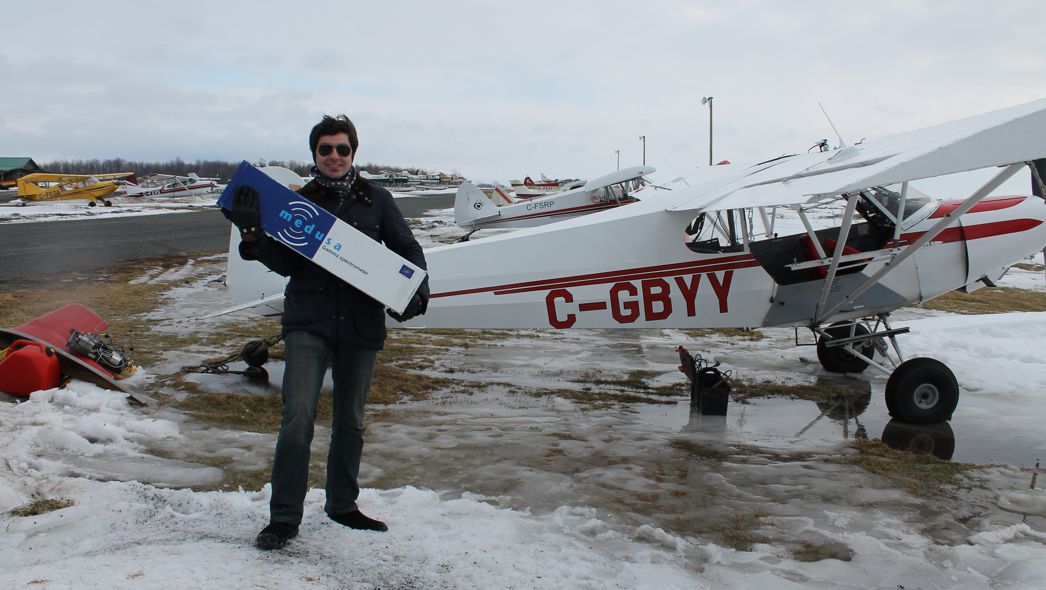Mineral exploration
Radiometrics is one of the geophysical tools used as a standard in mineral exploration. Regional surveys are conducted from plane-borne measurements while smalls-scale, detailed, surveys can be conducted from ground spot sampling or walking surveys.

For a successful application of geophysical methods in mineral prospecting, there should be a measurable physical contrast between the ore bearing rocks and the surrounding material. For the application of radiometrics in mineral exploration, this can be caused by:
The concentrations of radionuclides in ore minerals and host rocks can differ due to differences in lithology.
The concentrations of uranium, thorium and (mainly)potassium can change due to geochemical alteration processes. Variations in concentrations of the radionuclides or in ratio's between the nuclides in the field can point to zones with the geochemical alterations.
Papers of Ford et. al. (2007) and Airo (2015) give a good overview of the radiometric signatures of mineral deposits in Canada and Finland. The description of the deposits in the text below are a summary of these papers and give an indication of the potential application of radiometrics for mining exploration. In the table below, the application of radiometrics for prospecting in a geological framework (global mapping) or direct targeting (by point measurements on the ground) is divided as highly effective (++), effective (+), not effective (-).
Application | Geological framework | Direct targeting |
|---|---|---|
Diamonds | + | - |
Gold | ++ | + |
VMS deposits | ++ | + |
SEDEX deposits | ++ | - |
Uranium deposits | ++ | ++ |
Carbonatites | ++ | ++ |
Magmatic Ni-Cu-PGEs deposits | + | - |
Porphyry Cu | ++ | ++ |
Lithium | ++ | ++ |
Diamonds
Diamond deposits are Kimberlite craters containing diamond xenocrysts. These deposits are often associated with Ilmenite and Magnetite.
There are no geophysical methods that directly measure the presence of diamonds but (airborne) magnetics is a common method used for mapping kimberlite pipes. Radiometrics is an effective additional signal for understanding the regional geology in these surveys.
Gold Deposits
Gold deposits are formed by hydrothermal processes. There is a variety of sub-types, most of which can be grouped into three main categories (Lydon, et al., 2004):
Shear and fault zone-related deposits (Au-Quartz) associated with collisional tectonics.
Intrusion-related deposits associated with felsic plutons of subaerial, oceanic and continental setting.
Epithermal deposits (High- and Low-Sulphidation) associated with sub-aerial and shallow marine environments.
Gold deposits are often associated with minerals as: Pyrite, Sericite/Illite, Alunite, Adularia, Kaolinite, Muscovite, Magnetite.
For chemically altered hydrothermal deposits that are typical for orogenic gold systems, the alteration often introduced high amounts of potassium. Since uranium is generally mobile, the U/Th ratio will be low for these deposits.
For shear and fault-zone (Au-quartz vein) deposits, airborne radiometrics can give help to delineate lithologies and find associated faults and shear zones. At a deposit scale massive quartz veins are often associated with alteration (potassium highs). Regional potassium highs associated with felsic volcanism and local potassium highs with corresponding low Th/K associated with potassic alteration can be used for epithermal styles of mineralization.
Volcanogenic Massive Sulphide (VMS) Deposits
A VMS deposit formed by sea floor venting of hydrothermal fluids in submarine volcanic environments and is a concordant body of massive iron, copper, zinc and sometimes lead sulfides. VMS deposits contain commodities as Cu, Zn, Pb, Ag, Au. The deposits are ofte associated with Pyrrhotite, Magnetite, Sphalerite, Galena, Chalcopyrite.
There is no direct relation between VMS ore and the concentrations of radionuclides, but the concentrations of K, U and Th can give some evidence of hydrothermal alteration related to mineralization process (VMS or any other).
The processes related to hydrothermal alteration can result in changes in the ratios of the radionuclides. K is mostly affected by hydrothermal processes. Th is less affected and the concentration of U only rarely. The radio's of the radionuclides (e.g. K/Th) from geological framework mapping can be used in exploration to detect the halos that are related to the alteration mineralization.
SEDEX Base Metals Deposits:
SEdimentary EXhalative (SEDEX) sulphide deposits are found in sedimentary basins, usually in the form of a lens having typical aspect ratios of 20, and maximum thicknesses of 5 to 20 m. SEDEX deposits contain commodities as Pb and Zn, and contain ore minerals as sphalerite and galena; chalcopyrite may be a very minor component. Pyrite is the most abundant sulphide, though pyrrhotite may also be common.
The sulphide deposits can often be outlined with the concentrations and of radionuclides as areas of mineralization. A process of sericitic alteration, alters the minerals by hydrothermal fluids that invade the permeable rock. Plagioclase feldspar within the rock is then converted to a fine-grained white mica. this alteration results in elevated potassium values and depleted thorium/potassium ratios, relative to unmineralized host rocks.
Uranium Deposits
Uranium Deposits are located typically at/near the base of Proterozoic sandstone sequences resting on metamorphic basement. Faults and fractures that intersect the sequence determine the locations of mineralization and control deposit geometry/orientation. The deposits can have thicknesses of tens of meters and can have a size up to 1000 of metres. The main commodity is U and minerals associated with this deposit is Pitchblende and Coffinite.
The uranium (if not covered by a thick outcrop) can be measured directly by gamma-ray spectrometry. If the deposit is deeply buried, radon (a decay product in the decay chain of uranium) can escape through faults and fractures and can point to the presence of uranium in deeper formations.
Carbonatites
Carbonatites (the often mentioned Olympic Dam Type Copper-Gold-Iron Oxide Deposits contain Carbonatites) is a type of intrusive or extrusive igneous rock that contains a percentage of carbonate minerals larger than 50%. These type deposits usually occur as small lenses within zoned alkalic intrusive complexes, or as sills, dikes, breccias, and veins. They are almost exclusively associated with continental rift-related tectonic settings. Carbonatites contain commodities as Cu, Au, Nb, P, REE, especially LREE, Ag and U (+/- As, B, Ba, Bi, Co, F, Mo, Mn, Ni, W, Te). Various minerals are associated with Caronatites: Iron oxide (hematite, martite, magnetite, specularite), Cu sulphides (chalcopyrite, bornite, chalcocite), uraninite, coffinite, sericite, K-feldspar.
Radiometrics is important for regional mapping focussing on high uranium levels, and uranium/thorium anomalies that give a direct indication of U enrichment in hydrothermal alterations. High levels of potassium and low thorium/potassium ratios indicate regions with K-feldspar alteration.
The EU project HiTech AlkCarb investigates new geomodels and sustainable exploration methods for alkaline igneous rocks and carbonatites.
Magmatic Nickel-Copper-PGE Deposits
Magmatic Nickel-Copper-PGE Deposits are Ni-Cu concentrations in mafic-ultramafic igneous intrusions and volcanic flows. These deposits host ±40% of the global resources of nickel (Ni), >99% of platinum-group elements (PGE) and ±3% of copper (Cu).
The Ni-Cu deposits are very conductive and, therefore, give rise to a strong EM response. In addition to EM measurements regional mapping of natural radioactivity show how low the concentrations of K,U and Th in magmatic and ultramagmatic rocks makes radiometrics a valuable tool for identifying massive sulphides by the low anomalies.
Porphyry Copper Deposits
A Porphyry Copper Deposit is a base metal mineralization associated with hydrothermal alteration of a felsic pluton and adjacent wallrocks. These deposits containmainly Cu as commodity, but also Au, Mo, Ag, Sn and W can be found. The mineralization can be associated with Magnetite, but hydrothermal alteration may destroy magnetite. Other minerals associated with this mineralization are pyrite, chalcopyrite, biotite, K-feldspar, sericite.
The biotite and K-feldspar will result in potassium anomalies (highs) and low Th/K ratio's can also point to the presence of biotite and K-feldspar alterations. Radiometrics can be used for geological mapping and can be used to quickly identify potassic alterations.
Pegmatite-Lithium deposits
Lithium can be found in various geological settings, such as pegmatites, brine deposits, and lithium-rich clays.
Pegmatite is a coarse-grained intrusive igneous rock formed from crystallized magma below the Earth’s crust. Pegmatite lithium deposits, also known as hard-rock lithium deposits, can contain extractable amounts of a number of elements, including lithium, tin, tantalum and niobium.
Gamma-ray spectrometers are used for pegmatite exploration. In this studies, the goal is to identify areas with anomalous gamma-ray emissions that are indicative of the presence of radioactive elements associated with pegmatite-forming minerals. Pegmatites commonly exhibit higher concentrations of potassium (40K) compared to surrounding rocks. Pegmatites may also exhibit increased concentrations of uranium (238U) and thorium,(232Th) Anomalies of these elements can be used to identify areas with potential pegmatite mineralization.
Australia, the US, Canada, Ireland, Finland and the Democratic Republic of Congo are known to host pegmatite lithium deposits. The top-producing spodumene pegmatite operation, known as the Greenbushes mine, is located in Australia,
More information:
https://pubs.usgs.gov/sir/2010/5070/o/sir20105070o.pdf
http://www.mining.com/web/lithium-supply-demand-story/
References
Airo, M.-L., 2015. Geophysical signatures of mineral deposit types in Finland. Geol. Surv. Finland, Spec. Pap. 58, 144.
